Fresh Yet Historical Times Two
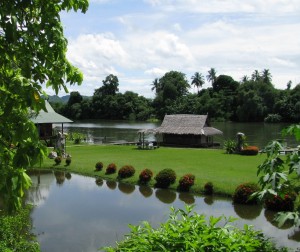 Kanchanaburi is a land forever cloaked in history. Renowned across the globe for its famous WWII landmarks – Bridge over the River Kwai (Kwae) and the Death Railway – this westernmost province was used by the Japanese army as a strategic supplies route into neighbouring Burma and beyond. Enclosed by verdant forests, then opening out onto a sheer cliff – just barely hanging on the edge – before crossing the Kwai Yai River at the Bridge over the River Kwai, the Death Railway is, today, one of the most scenic rail routes in the country.
Kanchanaburi is a land forever cloaked in history. Renowned across the globe for its famous WWII landmarks – Bridge over the River Kwai (Kwae) and the Death Railway – this westernmost province was used by the Japanese army as a strategic supplies route into neighbouring Burma and beyond. Enclosed by verdant forests, then opening out onto a sheer cliff – just barely hanging on the edge – before crossing the Kwai Yai River at the Bridge over the River Kwai, the Death Railway is, today, one of the most scenic rail routes in the country.
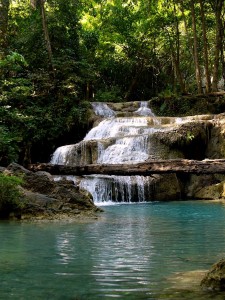 History, however, is only part of what Kanchanaburi has to offer as the province boasts a beautiful natural landscape of dense tropical jungles, crisscrossing rivers and streams, and spell-binding waterfalls with emerald-coloured pools. The idyllic Kwai Noi River cuts through lush valleys flanked by sheer cliffs on both sides, making for a great river journey by a bamboo raft or long-tail speedboat.
History, however, is only part of what Kanchanaburi has to offer as the province boasts a beautiful natural landscape of dense tropical jungles, crisscrossing rivers and streams, and spell-binding waterfalls with emerald-coloured pools. The idyllic Kwai Noi River cuts through lush valleys flanked by sheer cliffs on both sides, making for a great river journey by a bamboo raft or long-tail speedboat.
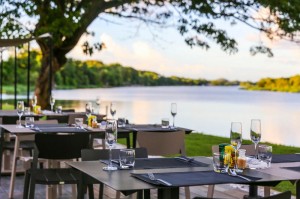 X2 River Kwai is a dreamy resort that can be found in Nong Ya, within the Mueang Kanchanaburi District of Kanchanaburi in Thailand. Designed with utmost attention to detail by Agaligo Studio, the resort was completed in 2014 and was built alongside a picturesque stretch of the Kwai Noi River. Flanked by a mountain range, a river, sugar cane plantations and rice paddies, this is definitely a perfect vacation destination for those of you who are looking for a tranquil corner of paradise away from the chaos of a big city.
X2 River Kwai is a dreamy resort that can be found in Nong Ya, within the Mueang Kanchanaburi District of Kanchanaburi in Thailand. Designed with utmost attention to detail by Agaligo Studio, the resort was completed in 2014 and was built alongside a picturesque stretch of the Kwai Noi River. Flanked by a mountain range, a river, sugar cane plantations and rice paddies, this is definitely a perfect vacation destination for those of you who are looking for a tranquil corner of paradise away from the chaos of a big city.
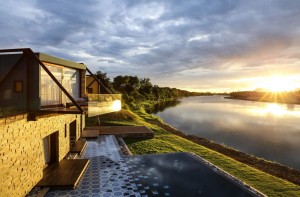 The X2 River Kwai resort was built with sustainability and eco-friendliness in mind, and so its entire construction process was centered around the principle of a “light structure”. However, aside from its lightness, the resort also impresses with highly efficient insulation and with a series of modern, low-energy facilities. Examples include special electrical key tags that turn off electricity within the rooms when they are not inhabited, but we can also mention the high-end air conditioning systems that are turned off if a door is left open for more than 5 minutes. The theme carries on with LED lighting arrangements that use substantially less power when compared to conventional artificial lighting.
The X2 River Kwai resort was built with sustainability and eco-friendliness in mind, and so its entire construction process was centered around the principle of a “light structure”. However, aside from its lightness, the resort also impresses with highly efficient insulation and with a series of modern, low-energy facilities. Examples include special electrical key tags that turn off electricity within the rooms when they are not inhabited, but we can also mention the high-end air conditioning systems that are turned off if a door is left open for more than 5 minutes. The theme carries on with LED lighting arrangements that use substantially less power when compared to conventional artificial lighting.
L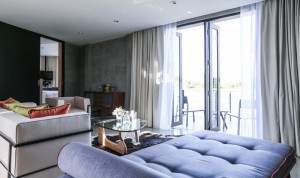 ast but not least, nature also helps keep this place green, cool and welcoming. Numerous large rain trees were left unharmed during the development process because the architects were well aware of their potential for energy saving and Co2 absorption. Furthermore, the nearby river provides plenty of water that can be used for local irrigation.
ast but not least, nature also helps keep this place green, cool and welcoming. Numerous large rain trees were left unharmed during the development process because the architects were well aware of their potential for energy saving and Co2 absorption. Furthermore, the nearby river provides plenty of water that can be used for local irrigation.
The province of Kanchanaburi played many important roles in the past centuries during the Thai-Burmese conflict. It was a place full of several ethnic tribes living in thick jungles and also a spot for mining activities. The town became widely recognized after the Second World War, when the Japanese soldiers used it as a base camp for the prisoners of war to construct the notorious Thai-Burma Railway and the well-known bridge over the River Kwai. This memoir was later featured in the 1957 Hollywood film, “The Bridge on the River Kwai,” winning 7 academy awards. Consequently, “The Railway Man,” screened in 2014, was produced to recite the historical event.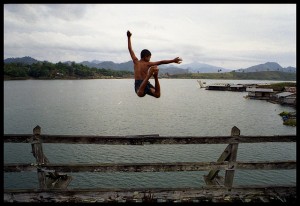



 0
0